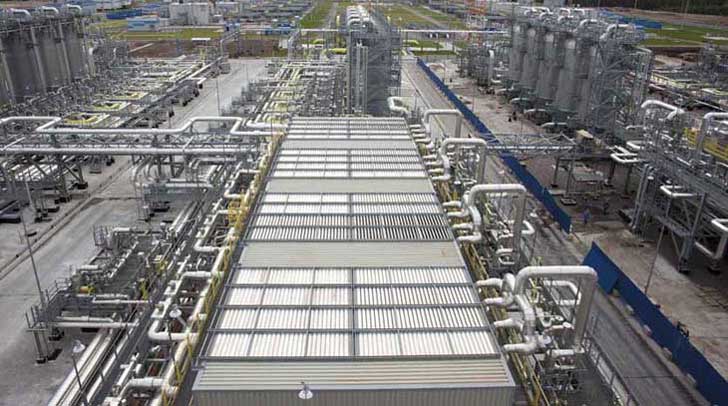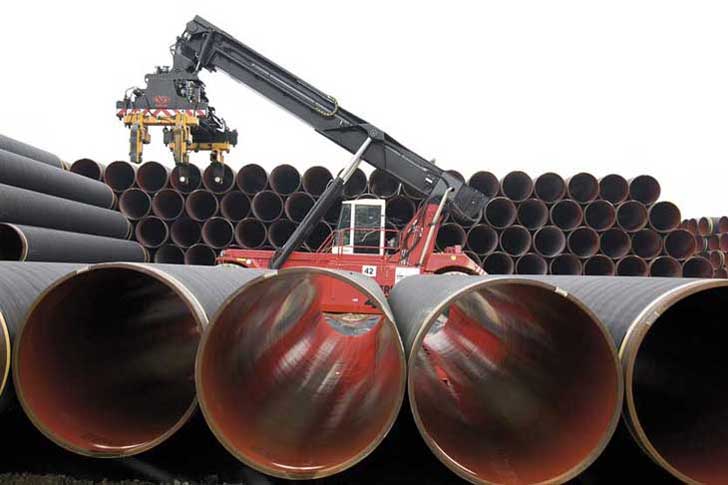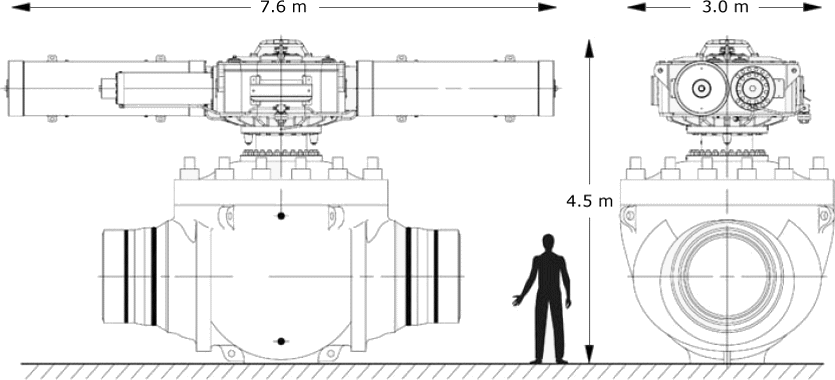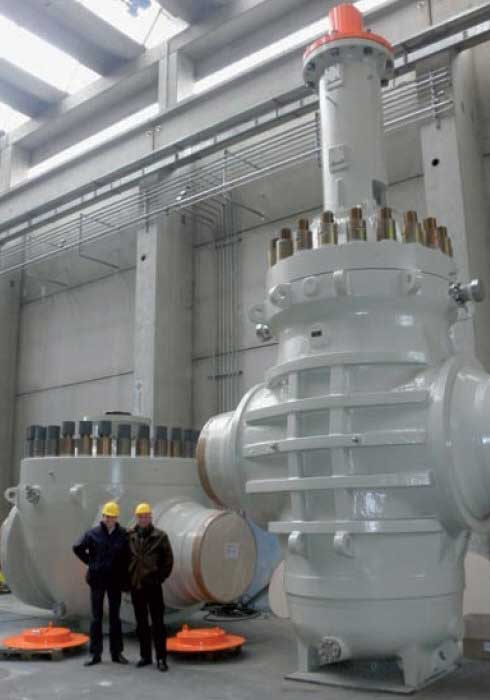
Pipeline Manufacturing of Large Steel Components
Nord Stream is the gas supply route from Russia through the Baltic Sea to Europe and represents one of the new pipeline projects for guaranteeing Western European gas supply in the future. The project is the longest 48in offshore pipeline to date, April 26, 2014. The combination of large diameter and high design pressure meant that the materials for all components had to be carefully defined and specified. A considerable effort was made in the project to prequalify suppliers and to supervise the manufacturing phase to ensure that the high quality requirements were achieved. This article describes some technical considerations made when selecting the suppliers of line pipe, bends and valves.
Nord Stream's natural gas pipelines stretch across the Baltic Sea from Portovaya Bay near the town of Vyborg, Russia, to Germany's Baltic coast at Lubmin, near Greifswald. The Main Control Centre is in Zug, Switzerland. Each pipeline is 1,224 kilometres long and has a design capacity of 27.5 billion cubic metres (bcm) a year. The first of the twin pipelines became operational in November 2011 and has been transporting natural gas since then to Gazprom's partners and customers in Europe. The second line came on stream as part of the fully-integrated system on October 8, 2012.
Each line consists of approximately 100,000 24-tonne concrete weight coated steel pipes laid on the seabed. Nord Stream was able to design the pipeline to operate without an intermediate compressor station. Gas travels the full 1,224 kilometre distance to Germany's Baltic coast thanks to input pressures of up to 220 bar generated by Gazprom's state-of-the-art compressor station.
The Compression Station is located at Portovaya near Vyborg in Russia. The GTU of the Compressor Station Portovaya removes condensate or gas hydrates, which occur under certain pressure and temperature conditions. The unit is designed to dehydrate up to 170 million cubic meters of natural gas daily. Following treatment, gas flows into the compressor area, and is brought up to the requisite pressure, after which it is subjected to fiscal measurement and fed into Nord Stream.
 Gas Treatment Unit Portovaya.
Gas Treatment Unit Portovaya.
The pipelines have a constant internal diameter of 1,153 millimetres. However, Nord Stream designed the pipeline with three different design pressure sections (220, 200 and 177.5 bar) and pipe wall thicknesses (34.4, 30.9 and 26.8 mm respectively) corresponding to the gas pressure drop over the long journey from Russia to Germany.
By designing each section according to the changing pressures, Nord Stream was able to save on the amount of steel used, and thus the costs of the pipes. Each pipeline was laid in three sections, which were subsequently connected underwater off the coasts of Finland and Sweden by two hyperbaric tie-ins at sea depths of approximately 80 metres and 110 metres.
The selection of Line Pipe material and steel components meeting the requirement for 50 years design life under harsh conditions and very high operating pressures.
The project start an extensive qualification program for pipe mills and other suppliers of materials. Only very few of the large diameter pipe mills in the world could prove that they had a sufficient track record with DNVgrade SAWL 485 (similar to grade X70) for wall thicknesses ranging from 26.8 to 34.4mm.
Therefore, some additional pipe mills, with promising potential but with lack of relevant track record, were invited by Nord Stream to perform a trial production and to demonstrate their capability. The trial production requirement was to produce 20 plates (all produced in sequence) and thereafter to produce 20 pipes from these plates, all of which had to meet the Nord Stream specification.
These requirements proved to be tough and some of the pipe mills invested in new equipment, procedures and personnel in order to improve their capabilities. Three pipe mills managed to pre-qualify through a trial production, so that in total six pipe suppliers were qualified to participate in the tender. The volume of line pipe required by the Nord Stream Project exceeded 2 million tons of steel, and there was strong interest from the pipe industry to participate.
The line pipe supply contracts were awarded to Europipe (Germany), OMK (Russia) and Sumitomo (Japan). Pipe delivery started in May 2008 and is scheduled to be completed by mid 2011.
 Storage of pipe joints at Mukran, Germany. Bare pipe joints are stored by a so called reach stacker next to the Baltic Sea in Mukran, Germany, where they receive the reinforced concrete coating.
Storage of pipe joints at Mukran, Germany. Bare pipe joints are stored by a so called reach stacker next to the Baltic Sea in Mukran, Germany, where they receive the reinforced concrete coating.
Hot Induction Bends for the Nord Stream Project. The companies which were experienced and sufficiently qualified to supply large diameter bends to Nord Stream specifications were also very few. At both the Russian and German landfalls, the Nord Stream Project required several induction bends with high material strength, good ductility at low temperatures, and with a high wall thickness due to the high design pressure. All bends were specified as fully quenched and tempered (QT) with tight geometric tolerances.
Salzgitter Mannesmann Grobblech GmbH (MGB) in Mülheim, Germany, was successful with their bid and won a contract for the supply of 38 large diameter bends to the Nord Stream Project, see Table 1.
Ten 48in bends were required at the German Receiving Terminal. The 28in and 38in bends listed in Table 1 are installed near the compressor station on the Russian coast and near the Receiving Terminal on the German side. Due to their different application, different specification standards and test requirements had to be respected, as shown in Table 1 and 2. To meet the low-temperature test requirements, the bends were fabricated from multilayer longitudinal submerged arc welded (LSAW) mother pipes, produced by pipe mill Eisenbau Krämer (EBK), which also supplied the buckle arrestors in 48in x 41 mm WT for the Nord Stream Project.
To minimise the risk of pipe collapse during installation, buckle arrestors (pipe reinforcement) are installed at specific intervals in susceptible areas. The buckle arrestors are welded into the pipelines in those areas that are susceptible to propagation buckling, i.e., deeper sea areas.
The buckle arrestors are made of the same steel alloy as the line pipes and are equal in length to the line pipes. However, these pipes has a greater wall thickness, with machined thinner wall ends to match the adjoining line pipe.
Buckle arrestors are used along a 305 km stretch of the pipeline, and the spacing between them is 927m (equal to 76 line pipes).
 Transfer of a 48in bend for the Nord Stream Project from the heat treatment furnace to the quenching bath at the MGB bending plant.
Transfer of a 48in bend for the Nord Stream Project from the heat treatment furnace to the quenching bath at the MGB bending plant.
The 28in and 38in bends were fabricated in material grade L 485, the same grade used for the line pipes. In the case of the 48in bends, however, the requirement was reduced to grade L 450. The reason for this was the necessity to "overdesign" the wall thickness of the 48in bends in order to maintain suitable geometric stability during full body QT post bending heat treatment.
Regarding the operational conditions for the main line and the adjoining line pipe dimension, 48in bends in material grade L 485 fabricated from mother pipes in dimension of 48in x 34 mm wall thickness would have been sufficient, but due to the unfavourable ratio of wall thickness to outer diameter (OD) regarding the risk of deformation and collapse during austenitisation, the wall thickness for these mother pipes had to be increased to a minimum of 38.0 mm. For this reason, the required strength level of the 48in bends could be reduced to grade L 450.
|
Table 1.. Pipe Bending Plant of Salzgitter Mannesmann Grobblech/ Europipe is supplying 38 large diameter bends to the Nord Stream Project |
||||||
| Qty. | Size | Angle | Radi | WT after bending |
Grade | ton pcs |
| Pc | inch | ° | mm | |||
| 16 | 28 | 90 | 3D | 28.5 | L 485 | 2.67 |
| 3 | 28 | 60 | 3D | 28.5 | L 485 | 1.98 |
| 3 | 48 | 93.33 | 5D | 35.0 | L 450 | 12.59 |
| 7 | 48 | 90 | 5D | 35.0 | L 450 | 12.19 |
| 9 | 38 | 45 | 3D | 30.2 | L 485 | 2.75 |
|
Table 2.. Mother pipe dimensions and fabrication standards for the Nord Stream bends |
||||||
| NPS | Mat | Mother pipe dimensions [mm] ID x min. wt |
Fabrication standard |
Location | ||
| 28 | L 485 | 654.0 x 35.0 | ISO 3183 | Russia | ||
| 38 | L 485 | 904.6 x 35.4 | EN 10208-2 | Germany | ||
| 48 | L 450 | 1153.0 x 38.0 | DNV-OS F-101 |
Germany | ||
Large Valves for the Nord Stream Project. A similar qualification program was initiated by Nord Stream for the suppliers of large valves. In 2007, there was no manufacturing experience in the valve industry with 48in top entry ball valves and 48in double expanding gate valves and with a design pressure of 220 barg and a weight above 100 tons. Hence Nord Stream initiated a design competition where potential valve suppliers were invited to present a detailed design for the safety critical pipeline valves. The design work was compensated by Nord Stream to assure that all vendors involved their most qualified engineers and resource(s) to develop the best possible valve designs.
Special focus was put at the early design stage in the selection of the mainline actuated valves, which have the functions of pipeline Pressure Protection (PPS), Emergency Shut-Down (ESD) and Isolation. The development of the isolation system of the pipelines was driven by the achievement of high levels of safety, reliability and availability over the system design life.
48in, Top-Entry metal-seated Ball Valves (PPS and ESD) and Double-Expanding Gate Valves (Launch and Receive Traps isolation) were selected as the most appropriate valve types for their operational function.
The valve designs were assessed by Nord Stream experts in detail and the main criterion for the selection of the valve supplier was the confidence that the valves would be safe, functional and practically maintenance free for the next 50 years.
Ultimately, 10 valves were engineered and manufactured by Italy's Petrolvalves Srl, one of the world's leading suppliers of industrial valves for the petroleum and petrochemical sectors.
The valves were extensively tested in Italy before being transported to Germany and Russia on trucks specially made for such high loads. Such large components can only be transported at night, and with a police escort.
The complex logistic arrangements to transport the massive valves from Italy to Germany and over land and sea to St. Petersburg have been handled by Saving Shipping and Forwarding Srl, also based in Northern Italy.

Top Entry Ball valve with Spring Return Actuator

48in, Top-Entry metal-seated Ball Valve (left)
and Double-Expanding Gate Valve
Project Players
Nord Stream Gas Purchasers
- Gazprom Marketing and Trading Ltd, UK
- DONG Energy A/S
- GDF SUEZ S. A.
- WINGAS GmbH and Co. KG
- E.ON Ruhrgas AG
Logistics
- EUPEC
- Port of Sassnitz-Mukran
- Port of Kotka
- Port of Hanko
- Port of Slite
- Port of Karlskrona
Pipes and Materials
- EUROPIPE
- OMK
- Sumitomo
- Petrol Valves
Environmental Studies, Quality Management and Safety
- Marin Mätteknik
- Rambøll
- DoF
- PeterGaz
- ERM
- DNV
- FOGA
- SGS TÜV
Construction
- Saipem
- Allseas
- Van Oord
- Boskalis-Tideway
- Rohde Nielsen
Operations
- Technip
- Statoil
- Siemens
- IMPaC
Concrete weight coating & logistics services were provided by EUPEC PipeCoatings S.A. For the concrete weight coating new coating plants were constructed in Mukran (Germany) and Kotka (Finland). Rolls-Royce plc supplied eight industrial aeroderivative gas turbines driving centrifugal compressors for front-end gas boosting at the Vyborg (Portovaya) gas compressor station. Dresser-Rand Group supplied DATUM compressors and Siirtec Nigi SPA provided a gas treatment unit for the Portovaya station.
For the construction period, created a logistic center in Gotland. Other interim stock yards are located in Mukran, in Kotka, in Hanko (Finland) and in Karlshamn (Sweden).
Reference(s) for the images and text, is owned by Nord Stream AG